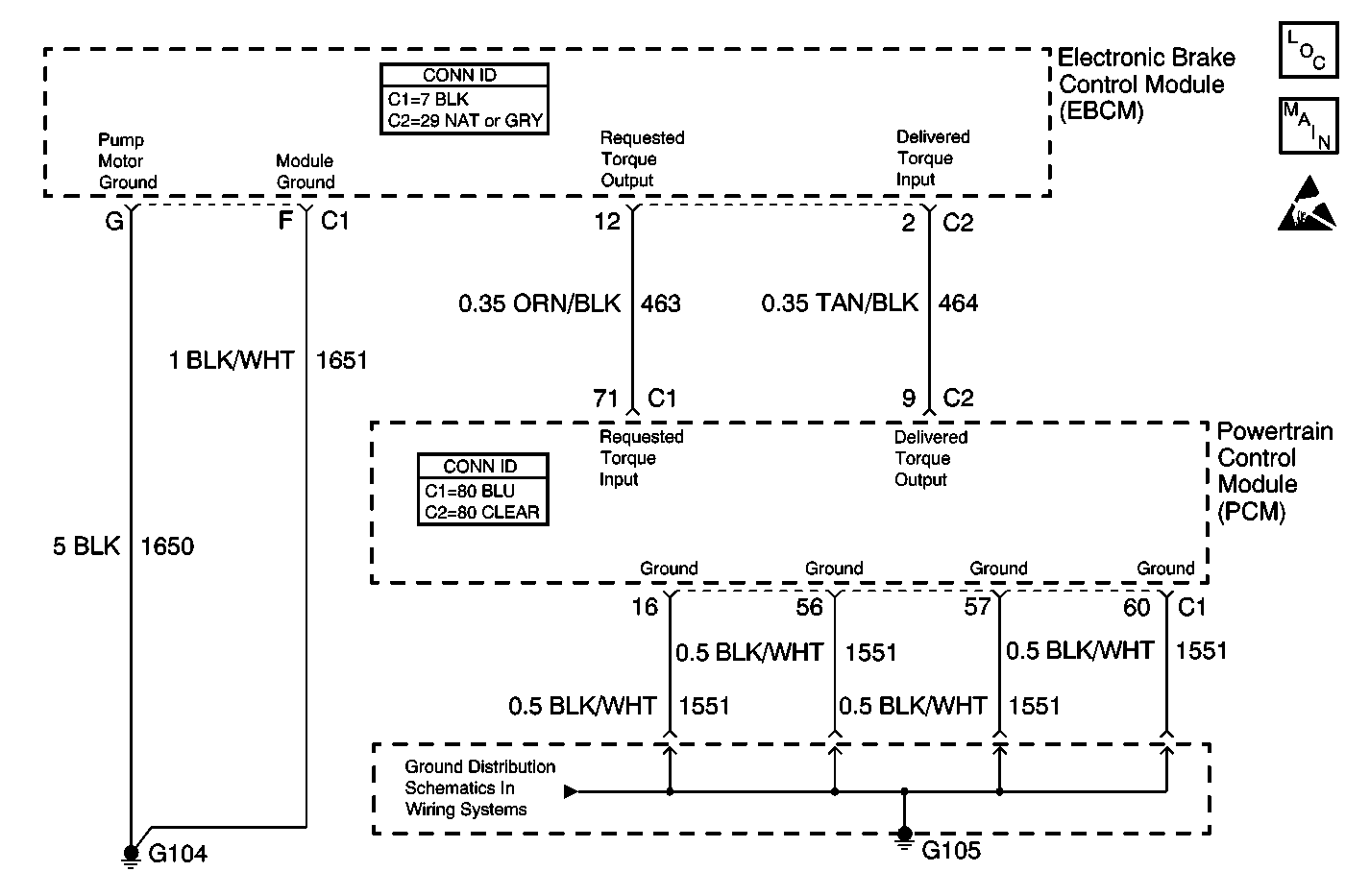DTC C1276 Delivered Torque Signal Circuit Malfunction w/NW9

Circuit Description
The EBCM and the PCM simultaneously control the traction control. The PCM sends a Delivered Torque message via a pulse width modulated (PWM) signal to the EBCM. The duty cycle of the signal is used to determine how much engine torque the PCM is delivering. Normal values are between 10 and 90 percent duty cycle. The signal should be at low values (around 10 percent) at idle and higher values under driving conditions. The EBCM supplies the pull up voltage that the PCM switches to ground to create the signal.
Conditions for Running the DTC
The ignition is ON.
Conditions for Setting the DTC
One of the following conditions occurs:
| • | The delivered torque PWM signal is less than 5 percent duty cycle or greater than 95 percent duty cycle. |
| • | The EBCM does not receive a delivered torque PWM signal for a period of 7 seconds. |
Action Taken When the DTC Sets
| • | The EBCM disables the TCS for the duration of the ignition cycle. |
| • | The TRACTION OFF indicator turns ON. |
| • | The ABS remains functional. |
Conditions for Clearing the DTC
| • | The condition for the DTC is no longer present and the DTC is cleared with a scan tool. |
| • | The electronic brake control module (EBCM) automatically clears the history DTC when a current DTC is not detected in 100 consecutive drive cycles. |
Diagnostic Aids
The following conditions can cause this concern:
| • | An open in the delivered torque circuit. |
| • | An short to ground or voltage in the delivered torque circuit. |
| • | A wiring problem, terminal corrosion, or poor connection in the delivered torque circuit. |
| • | A communication frequency problem. |
| • | A communication duty cycle problem. |
| • | The EBCM is not receiving information from the PCM. |
| • | Loose or corroded EBCM ground or PCM ground. |
Test Description
The numbers below refer to the step numbers on the diagnostic table.
-
This step uses the scan tool to determine whether the delivered torque signal has a valid duty cycle.
-
This step measures whether the delivered torque signal has a valid duty cycle.
-
This step measures whether the delivered torque signal has a valid frequency.
Step | Action | Value(s) | Yes | No | ||||||
|---|---|---|---|---|---|---|---|---|---|---|
1 | Did you perform the ABS Diagnostic System Check? | -- | Go to Step 2 | |||||||
2 | Inspect the EBCM ground and PCM ground, making sure each ground is clean and torqued to the proper specification. Refer to Circuit Testing and Wiring Repairs in Wiring Systems. Did you find and correct the condition? | -- | Go to Step 13 | Go to Step 3 | ||||||
Does the scan tool display within the specified range? | 5-95% | Go to Testing for Intermittent Conditions and Poor Connections in Wiring Systems | Go to Step 4 | |||||||
Important: If equipped with TIM, removing battery voltage or ground from the EBCM
will result in the following conditions.
Does the duty cycle measure within the specified range? | 5-95% | Go to Step 5 | Go to Step 6 | |||||||
Measure the DC Hz at the J 39700 universal pinout box between the delivered torque signal circuit and a good ground. Does the frequency measure within the specified range? | 121-134 Hz | Go to Step 10 | Go to Step 9 | |||||||
6 |
Does the voltage measure near the specified value? | B+ | Go to Step 7 | Go to Step 8 | ||||||
7 |
Did you find and correct the condition? | -- | Go to Step 13 | Go to Step 9 | ||||||
8 |
Refer to Circuit Testing and Wiring Repairs in Wiring Systems. Did you find and correct the condition? | -- | Go to Step 13 | Go to Step 10 | ||||||
9 | Inspect for poor connections the harness connector of the PCM. Refer to Testing for Intermittent Conditions and Poor Connections and Connector Repairs in Wiring Systems. Did you find and correct the condition? | -- | Go to Step 13 | Go to Step 11 | ||||||
10 | Inspect for poor connections the harness connector of the EBCM. Refer to Testing for Intermittent Conditions and Poor Connections and Connector Repairs in Wiring Systems. Did you find and correct the condition? | -- | Go to Step 13 | Go to Step 12 | ||||||
11 |
Important: The replacement PCM must be programmed. Replace the PCM. Refer to Powertrain Control Module Replacement/Programming in Engine Controls - 3.8L. Did you complete the repair? | -- | Go to Step 13 | -- | ||||||
12 |
Important: Perform the setup procedure for the EBCM. An unprogrammed EBCM will
result in the following conditions:
Replace the EBCM. Refer to Electronic Brake Control Module Replacement . Did you complete the repair? | -- | Go to Step 13 | -- | ||||||
13 |
Does the DTC reset? | -- | Go to Step 2 | System OK |
